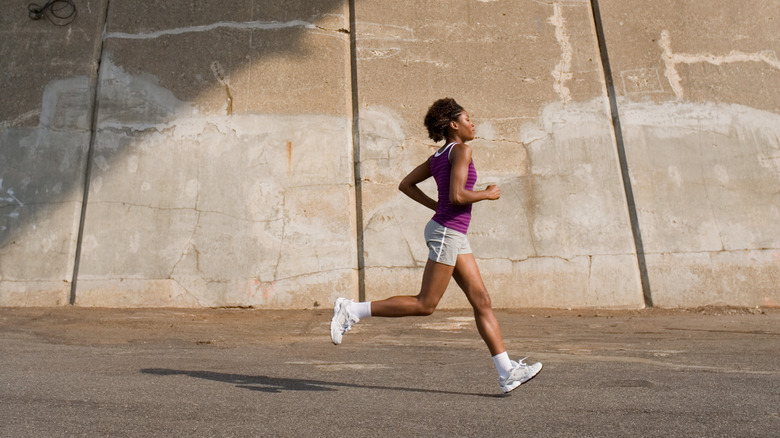Add This To Your Running Routine To Burn Twice As Many Calories
There are many reasons to love running. It's a chance to get outdoors and breathe in fresh air while giving your heart muscle (and overall body) a solid workout. Also, it's the exercise that burns the most calories.
But have you ever wondered if you could amp up your calorie burn even more while running? Turns out you can by incorporating high-intensity interval training, or HIIT, into your routine. Per a 2015 study published in The Journal of Strength and Conditioning Research, a 30-minute session of HIIT burned as much as 25%-30% more calories when compared with regular cardio and weightlifting done for the same amount of time. Depending on how you work it into your running routine, you could potentially end up burning twice as many calories with HIIT.
HIIT workouts, first introduced in the 1950s to help improve the performance of Olympic athletes, are characterized by short bouts of high-intensity exercises followed by low-intensity recovery periods. They're great for people whose chief complaint is that they don't have enough time to exercise because they don't have to be long to provide the same benefits as regular cardio or weight-training routines. A typical HIIT workout can last anywhere between just 10 minutes to 60 minutes. With HIIT, the goal is to reach 80%-90% maximum heart rate with short sessions of intense workouts as opposed to maintaining 50% of your maximum heart rate with lower-intensity, longer workouts.
Why HIIT could be good for you
In addition to the fact that HIIT exercises don't require the same amount of time to burn more calories when compared with regular cardio workouts or strength training, they're also great when it comes to increasing your metabolic rate post-exercise. What this typically means is that you'll be burning calories even after you're done with your training. Quite simply put, the more intense your workout, the greater the afterburn effect.
A 2015 study published in Sports Medicine – Open found that on average, HIIT produced greater post-exercise resting energy expenditure (REE) than aerobic endurance exercise and high-intensity resistance training. HIIT exercises are known to improve oxygen function. Per the American Council on Exercise, if you're looking for the most effective way to stimulate excess post-exercise oxygen consumption, or EPOC, HIIT should be on the top of your list.
HIIT workouts are also a great way to increase your heart and body's anaerobic threshold. By combining bouts of high-intensity exercise with low-intensity recovery periods, interval training engages both your aerobic (exercising with oxygen) and anaerobic (exercising without oxygen) abilities. During the anaerobic exercise period, which is the short but high-intensity exercise time, the energy expenditure comes from breaking down glucose that's already in your muscles. Additionally, HIIT workouts have been linked with lowering blood pressure, helping you tone up and lose fat, reducing blood sugar levels, and improving insulin resistance.
How to add HIIT exercises into your running routine
No, you don't have to sacrifice your running time to stay indoors and follow a HIIT workout on YouTube. You can simply incorporate 8-10 rounds of 30-second high-intensity running into your easy jog or brisk walk and see how you feel. If you're listening to music, you can remind yourself to add 30 seconds of fast-paced running after the end of one or two songs. If you've never done something of high intensity in short and fast intervals, it might take some time to get used to it.
The great thing about HIIT is that the high-intensity training can take any form — running, cycling, body-weighted training, etc. — so you can simply throw in a few seconds of amped-up workout time into your regular fitness regimen if you don't want to dedicate specific days for HIIT workouts.
Per a 2014 study published in the British Journal of Sports Medicine, HIIT exercises significantly improved cardiorespiratory fitness in people with coronary artery disease, heart failure, diabetes, hypertension, obesity, and metabolic syndrome, when compared with moderate-intensity continuous training (MICT). Still, it's important to get the all-clear from your doctor before pursuing something different as a form of exercise, particularly if you're recovering from an injury, have an underlying health condition, or you're overweight. The explosive nature of the exercise could result in muscle sprains, pulls, and tears. Knowing how HIIT workouts can really change your body also comes with understanding the risks.



